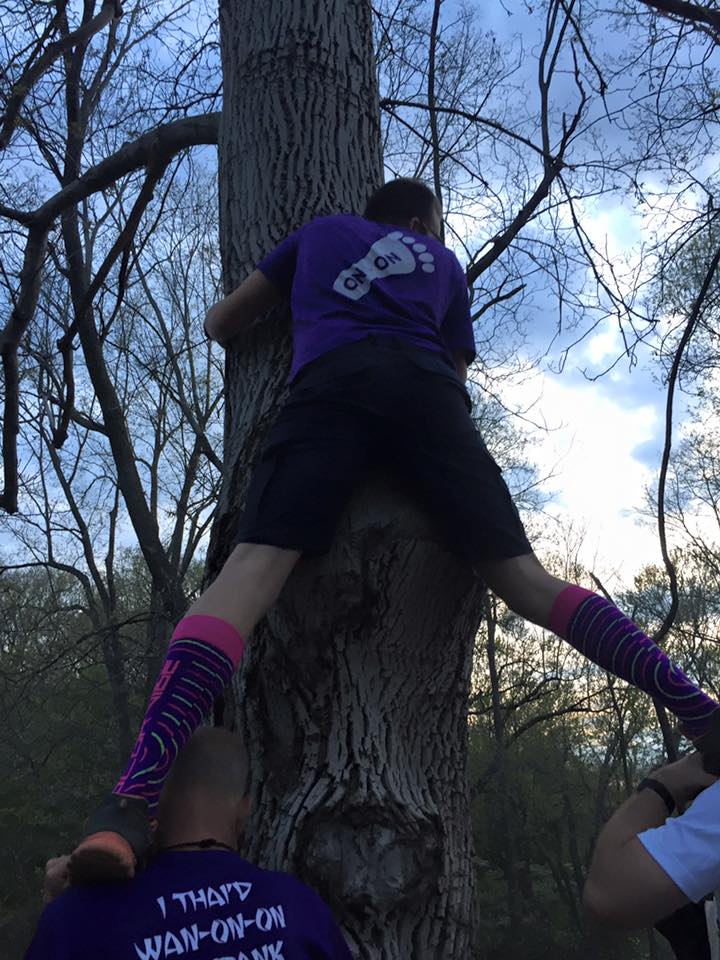Hash House Harriers
(From Wikipedia, the free encyclopedia)
The Hash House Harriers (commonly abbreviated "HHH" or "H3" and referred to as "The Hash") is a worldwide collection of loosely-associated running groups with a renowned penchant for merging running with social drinking. The Hash is frequently described as "a drinking club with a running problem," often when recruiting participants for group runs that tour local parks, wooded areas, cities, pubs and drinking venues. The organization of the HHH is completely decentralized, with chapters allowed to form and disband at any time and in any place. Individual hashes have their own customs and rituals, but almost all hashes share several major characteristics. A Hash run will consist of running a trail that is not disclosed ahead of time, but rather is marked by some means by a member of the group (in our case, flour aka anthrax, ricine, etc.). This tends to lead to unpredictable and dynamic running trails. At the end of the trail, participants hold a ceremony known as 'down-downs', drinking beer to celebrate the run. After attending several runs, participants will be given a 'hash name', which is generally based in either sexual innuendo or a specific memorable incident involving the new member. Hashers will almost always refer to each other by these 'hash names'.
A Short History of the Hash (From Flying Booger's Hash Primer at Half-Mind.com) Hashing began in Kuala Lumpur, Malaysia, in 1938, when a small group of British colonial officials and expatriates, led by A.S. Gispert, founded a running club called the Hash House Harriers. They named the group after their meeting place, the Selangor Club, nicknamed the Hash House. Hash House Harrier runs were patterned after the traditional British paper chase. A hare was given a head start to blaze a trail, marking his devious way with shreds of paper, all the while pursued by a shouting pack of "harriers." Only the hare knew where he was going...the harriers followed his clues to stay on trail. Apart from the excitement of chasing the hare and solving the clues, reaching the end was its own reward...for there, thirsty harriers would find a tub of iced beer. Hashing died out during WWII, and despite a brief revival in the late 1940s in the form of the Royal Italian Bordighera Hash, failed to take off again seriously until 1962, when Ian Cumming founded the 2nd kennel in Singapore. From then on, the phenomenon started to grow, spreading through the Far East, Australia, and New Zealand, as well as Europe and North America. Hashing really exploded in popularity in the mid-1970s. By the end of the 20th century, there were thousands of Hash House Harrier clubs in all parts of the world, with newsletters, directories, and even regional and world hashing conventions. This boom is owed largely to the power of the internet to provide timely and accurate information on kennels and their events and points of contact. As of this writing (2004), there are even two organized HHH groups in Antarctica.
How it is done: Hashing hasn't strayed far from its Kuala Lumpur roots. A typical hash today is a loosely-organized group of 20-100 men and women who meet weekly or biweekly to chase the hare. Not all groups are co-ed, though, and some chapters in major metropolitan areas have well more than 100 hashers at an event. In some countries there are Kids Hashes for those under 16. The paper has generally been replaced with flour, but chalk and toilet paper are still used. In tropical areas such as Brunei and Indonesia, different coloured paper is used because of the wet conditions The trails can be through residential areas, forests or swamps. Trails are usually laid by the "hares" in advance of the run but some Hashes operate with live "hares" whereby the "hares" set off with, say, a 10 minute start and the main pack tries to catch them, a form of athleticism frowned on by some of the more socially minded Hashes. Hashers run streets and back alleyways, ford streams, climb fences, explore storm drains, run through huge jungles and scale cliffs. And although some (but perhaps very few) of today's health-conscious hashers may shun a cold beer in favor of water or a diet soda, trail's end is still a party. In a few areas, bicycle hashes, BASHes, have been formed, based loosely on same principles, but often without the ceremonial aspects.
Goals of the Hash (From the 1938 charter of the Kuala Lumpur Hash House Harriers)
To promote physical fitness among our members.
To get rid of weekend hangovers.
To acquire a good thirst and to satisfy it with beer.
To persuade the older members that they are not as old as they feel.
Worldwide International Hash (INTERHASH) There are several international events, where hashers from different groups get together to run and drink beer together, but the most famous is the bi-annual Interhash, where hashers from around the world gather.
Many countries also hold biannual national events, such as the 2007 Vallarta , hosted by Mexico City, the Aussie Nash Hash 2007, Fat Cat Nash Hash hosted by the combined Canberra clubs and the United Kingdom Nash Hash, always held on the August Bank Holiday and next hosted by Milton Keynes H3.
Impact of the 9/11 attacks on the Hash After the 9/11/01 on the World Trade Center, several hashes, particularly those in the Washington, D.C. area, were approached by anti-terrorist agents concerned about the strange white powder (flour) used to mark the hash trail. As a result, those hashes have had to change their trail-marking techniques to use shredded paper, chalk, or paint. Hashers went back to flour off road in the Boston, MA area (home to the oldest hash in the United States), and around Frederick, MD, the very home of American anthrax.

